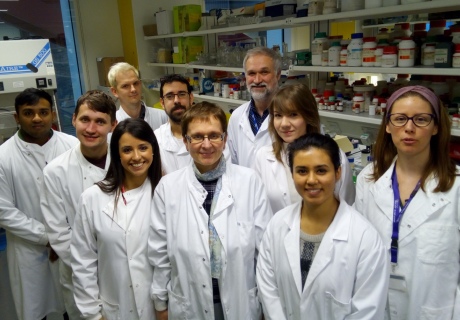

Professor Julia Gorelik of the National Heart and Lung Institute has received a British Heart Foundation (BHF) Programme grant.
The BHF grant is for over a million pounds and will allow Professor Gorelik to continue her research looking at microscopic changes that are related to heart failure. Her research involves using new technology to allow us to see nano-changes in the heart cell's structure that we couldn’t before. I caught up with Professor Gorelik to find out more about her work:
What is your research about?
Cardiac muscle cells (cardiomyocytes) are very structured cells with their main ion channels and receptors not randomly located but instead found in special micro-domains. Heart failure causes disturbance of these micro-domains. We are mainly working with these domains and the β-Adrenergic receptor calcium stimulated channels. These channels are responsible for cardiomyocyte contraction and therefore keeping your heart beating. During heart disease the cardiomyocytes change their function and structure and our research is trying to understand these changes better.
We work with a special pipette and scan the surface of living cells using high resolution scanning ion conductance microscopy to understand cell changes in the cardiomyocytes. The initial technology was developed in the Department of Medicine at Imperial College London by Professor Yuri Korchev and allows us to use scanning ion conductance microscopy to look at topographic changes in the surface of the cell. I combined this technique with fluorescence resonance energy transfer (FRET) technique so we can see the topography of cardiomyocytes and measure the number of live receptors.
We are working with live cells enabling the researchers to apply a signal locally to healthy heart muscle through the pipette to activate or de-activate receptors and channels. This allows us to understand the mechanisms of heart disease by exploring what effect this has on the function of the heart – for example, what combination of channels causes arrhythmia? We are also look at how damaged heart structures compare with healthy ones to see how structural changes effect heart function.
How could it effect patients?
We have found very interesting results on how different drugs work on the heart cells, this could inform the development of drugs for heart patients, and help us to understand the mechanism by which beta blockers work.
Our results are sent to our collaborator Professor Natalia Trayanova from Johns Hopkins University, Baltimore who has concluded that when a person has a lot of ion channels in the ‘crest’ area, as seen in failing heart cells, they get arrhythmia. So maybe the micro-domain under study is important for whole heart distribution of arrhythmia?
Why did you decide to go into this area of research?
Not many cells have such a good surface structure. When I started working with scanning ion conductance microscopy I imaged a lot of cells including cardiomyocytes, I found they had a stable surface structure and also the function of them is so important. They became one of my favourite cells! Nano changes in the cells led me to understand the big changes at whole heart level. I was excited by the future possible changes in drug development for real patients.
What do you think will be the next breakthough within the next 10 years?
I think that would be a drug for atrial arrhythmia – there are much fewer current potential drugs for this. Atrial cells are different to those found in the heart ventricle, this includes them having less t-tubules and different channel distribution. These nano differences have big effects on the function of the atrial cells.

Professor Gorelik is a cell biologist originally from St Petersburg, and she is now a Professor in Cellular Biophysics. Five of her previous postdocs now work in labs with this technology around the globe. Julia came to Imperial as a postdoc and started to work with completely new technology and was responsible for applying this ‘physics technique’ to biology. She cites her previous supervisor Professor Yuri Korchev and Professor Sian Harding as being influential in her career to date.
The grant is for the project entitled ‘Function follows form: improving the failing heart by targeting signalling nanodomains in myocytes’ and will run from 01/01/18 until 31/12/22.
This will be continuing her previous work but with a focus on β-Adrenergic receptor calcium stimulated channels. The work will be carried out with the BHF Centre of Excellence and BHF Cardiovascular Regenerative Medicine Centre based at Imperial College London.
Supporters

Article text (excluding photos or graphics) available under an Attribution-NonCommercial-ShareAlike Creative Commons license.
Photos and graphics subject to third party copyright used with permission or © Imperial College London.
Reporter
Ms Helen Johnson
Strategic Programmes & Change

Contact details
Tel: +44 (0)20 7594 6843
Email: helen.johnson@imperial.ac.uk
Show all stories by this author



